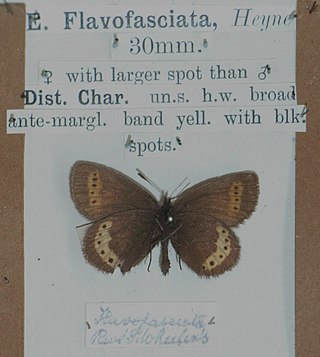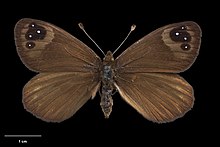
The small mountain ringlet or mountain ringlet is a butterfly of the family Nymphalidae. It is found in mountainous regions of southern and central Europe.

The Scotch argus is a butterfly of the family Nymphalidae. In spite of its English name argus, it is not a close relation of the brown argus nor the northern brown argus.

The forest ringlet, also known as Helms' butterfly, or te pēpepe pōuri or pepe pouri in the Māori language, is a rare butterfly of the family Nymphalidae endemic to New Zealand. It is the only species in the genus Dodonidia.

Erebiola butleri, or Butler's ringlet, is an elusive New Zealand endemic butterfly, discovered in 1879 by John Enys at the alpine pass at the head of the Rakaia River. It is the only member of the genus Erebiola.

Erebia is a Holarctic genus of brush-footed butterflies, family Nymphalidae. Most of the about 90–100 species are dark brown or black in color, with reddish-brown to orange or more rarely yellowish wing blotches or bands. These usually bear black spots within, which sometimes have white center spots.

Erebia euryale, the large ringlet, is a species of butterfly belonging to the family Nymphalidae.

Erebia alberganus, the almond ringlet or almond-eyed ringlet, is a butterfly of the family Nymphalidae.

Erebia tyndarus, the Swiss brassy ringlet, is a European brush-footed butterfly species of the subfamily Satyrinae.

The bright eyed ringlet is a member of the Satyridae subfamily of Nymphalidae. It is a high mountain butterfly found in the Pyrenees, Massif Central, Alps and Balkan mountains. It has recently been confirmed to occur in the southern chain of the Carpathians.

The yellow-banded ringlet is a member of the subfamily Satyrinae of the family Nymphalidae. It is a high mountain butterfly found in a small area of the Alps in Switzerland and Italy.

The marbled ringlet is a member of the subfamily Satyrinae of the family Nymphalidae.

The Styrian ringlet is a member of the subfamily Satyrinae of the family Nymphalidae. It is a mountain butterfly found in the Austrian and Italian Alps, Croatia and Slovenia.

The water ringlet is a member of the subfamily Satyrinae of family Nymphalidae. It is a high altitude butterfly found in the Alps, Bavaria, Styria, Pyrenees, Carpathians and Bulgaria.

Erebia cassioides, the common brassy ringlet, is a member of the subfamily Satyrinae of family Nymphalidae.

The false Mnestra ringlet, Erebia aethiopellus, is a butterfly of the family Nymphalidae found in France and Italy (Alps).

The Stygian ringlet is a butterfly belonging to the subfamily Satyrinae, the "browns", within the family Nymphalidae. It is found locally in the Alps on dry limestone slopes. It is very similar to the Styrian ringlet and has sometimes been included in that species.
Erebia polaris, the Arctic woodland ringlet, is a butterfly of the family Nymphalidae. It is found in Lapland and boreal Asia.

Argyrophenga antipodum, the common tussock or tussock ringlet, is a species of butterfly commonly found in the South Island of New Zealand.

Ichneutica maya is a moth of the family Noctuidae. It is endemic to New Zealand. It is found in the mountains in southern half of the North Island and in the South Island. I. maya is a distinctively coloured and patterned moth and as such is unlikely to be confused with similar species. I. maya can be found in the southern half of the North Island down through the South Island. This species can be found in alpine to subalpine zones with high rainfall but in Southland this species can be found down to sea level. This life history in the wild is unknown, nor has its larval host species been confirmed. Adults are on the wing from December to March and are attracted to sugar and light traps.

Ichneutica blenheimensis is a species of moth in the family Noctuidae. It is endemic to New Zealand and is found throughout the North, South and the Stewart Islands. This species appears to prefer drier eastern localities and is rarely collected in western North Island forested areas. It does not appear to be frequently collected in inland dry tussock grassland habitats. The host plant for the larvae of this species is likely to be the golden sand sedge pīngao which is now absent from the moths type locality. However Chappell has raised very young larvae on grass species and the more developed larvae consumed Phormium tenax. Adults are on the wing from November to March and are attracted to both light and sugar traps. The blackish forewing fringes are diagnostic of this species. But worn specimens of I. arotis can be confused with worn specimens of I. blenheimensis. However I. arotis can be distinguished from I. blenheimensis as it has a scale-tuft on the thorax and dark longitudinal stripes on the tegula. This species is classified as "At Risk, Naturally Uncommon" by the Department of Conservation.























